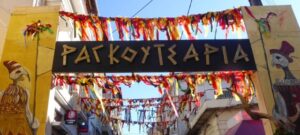“Ragouts,” “Fotarades,” camels, and the burning of goblins are some of the traditions of Epiphany, which have “roots” deeply hidden in the centuries and, along with the daring dive-bombers who brave the icy waters of January and plunge into seas and rivers to catch the Cross, are revived in several regions of Northern Greece.
The celebration of light – Epiphany “Ton Foton” is the baptism of Jesus Christ by John the Baptist. In Thessaloniki this year again, the ceremony of the consecration of the waters and the pouring of the Holy Cross will take place at the first pier of the harbour, on Monday, January 6, at 11 am by the Metropolitan of Thessaloniki, Filotheos.
Until 2023, the cross was being cast at Nikis Avenue, at the height of Aghia Sophia, but the Metropolitan of Thessaloniki decided to change the spot after seeing a black and white photograph from 1971. It was appreciated that the change of location offers easier access and an unobstructed view to the thousands of worshippers who wish to see the casting of the Cross and to those who decide to dive into the waters of Thermaikos.
“Ragoutsaria” stir up Kastoria
The Ragoutsaria is a three-day carnival event, starting on January 6 and ending on the 8th in Kastoria. The city of western Macedonia acquires a special colour and festive atmosphere.
The “Ragoutsaria” begins on the day of Epiphany and ends on January 8 (“Pateritsa”), with the parade of thousands of carnivalists. The city is “dressed up” festively, the orchestras, which are composed exclusively of brass and percussion instruments, give a special touch, while young and old alike organise themselves into “bouloukia” and dance non-stop in the streets.
The customs of the “Camel and the Bride” and the Fotarades in Halkidiki
The custom of “Camel and the Bride” is revived over the three days, January 5, 6, and 7 in Galatista, Halkidiki. The custom has its roots in the years of Turkish rule and is based on the fact of the abduction of a very beautiful girl, Manios, by the village Agas to lock her up in his harem. The lads of the village, led by her lover, unable to tolerate the kidnapping and the insult, reacted and decided to take the girl back. So they came up with the Camel’s trick, something similar to the Trojan Horse. And they succeeded!
On the second day, the custom includes the wedding of Mania, in which only men dress as bride and maid of honor, and this is an outgrowth of another era, back when women were not allowed to take part in men’s parties. The custom lasts for three days, in the square of Major John Hadjoudis in Galatista.
Also in Halkidiki, in Paleokastro, the custom of Fotarades is preserved, which starts on the eve of Christmas. A group of Kalantistas elects a “king” and all of them go together to the village church. The group then goes around singing the local carols, which culminate in individual wishes for each member of the family. On Christmas Day, the “king”, dressed in a cape, and the “Fotarades”, dressed in local costume and carrying large wooden swords, dance in the village square.
The “burning of the goblins” in Katerini
The “burning of the goblin” will be revived again this year, on the eve of Epiphany, in Ano Agios Ioannis of Katerini. It is a custom that symbolizes the exorcism of evil spirits, has its roots in Argos of Pontus, and has been revived for dozens of years.
Ask me anything
Explore related questions





